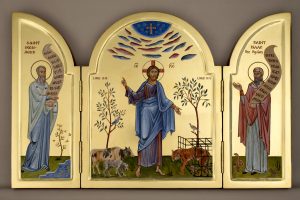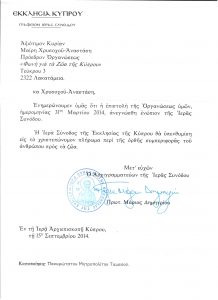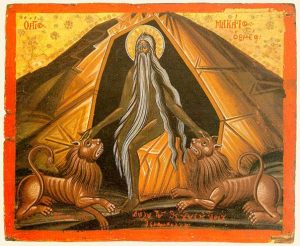This is a short post from Fr. J. Breck on the Orthodox Church in America website
March 2, 2004
POKER, R.I.P.
The other day we had one of our dogs “put down,” that is, euthanized. Actually he wasn’t even our dog. The neighbor had received him as a gift from his sister, had no interest in him, and neglected him completely, other than to toss a little food out to him in the evening. He was a beautiful animal, despite the matted hair, myriad ticks, and mud up to his tail from tramping through the marshes.
He was a thoroughbred English Spaniel, black and white, and gentle as a fawn. He had a fawn’s eyes, too, large, liquid and a little sad. His owner had named him Poker. When the fellow said we could keep him, the poor animal was afflicted with heart worms, hook worms, ear mites and an eye infection. When we got him back from the vet, some $300 later, he clung to us so closely we began to call him Cody, for “co-dependent.” But Poker he was, and Poker he remained.
The veterinarians, a man and a young woman, cared for Poker often during the three years he was ours. Last week, just before his tenth birthday, he stopped eating. Lethargy set in so that he could hardly get around. For a couple of days we nursed him at home, hoping it would pass. By the weekend, those deep, sad eyes told us we had to take him to the clinic. A blood test showed what we had feared: he had massive kidney failure. We could subject him to aggressive and painful treatment, the vet said, with no real chance of improvement. Or we could accept to put him to sleep. I thought about it, tried to pray about it—I loved this little creature—then called my wife, who drove up to join me.
The vets came in, both of them, and wrapped Poker in very genuine affection. One of them pulled out a box of tissues in case we needed them. His eyes reddened, and he reached for one himself. Then the young woman, in a gesture of remarkable tenderness, inserted the needle, as I cradled Poker’s head in my arms.
A moment later his heart stopped. The doctor touched his open eye with the tip of her finger and said quietly, “He’s gone.”
Gone where? She didn’t say “He’s dead,” rather, “He’s gone.” Trying to hold back my own tears, my mind went back to the first time I carried a cadaver. It was in a small Swiss village, in 1968. An elderly friend named Paul, a leader in his local parish, died one morning in the shower. His wife, choked with grief, called the pastor, and he called me. We found Paul where he had fallen, lifted him up, carried him to the bed, and covered him to the chest with a sheet. I looked at him, and realized that he was “gone.” Not dead, but simply gone, not there. This body stretched out on the bed was a shell, nothing more. Where was “Paul,” the real Paul that we had known and loved? Like Poker, he was gone.
In the few minutes we stayed with Poker, who was warm yet lifeless, I thought too of the first meeting I had with Father Lev Gillet, the much revered spiritual elder who wrote many brief and beautiful books under the name of “A Monk of the Eastern Church.” It was the summer of 1967, and he and I, together with my wife and our infant son, were strolling down a street in London (he was for many years chaplain of the London-based Society of St Alban and St Sergius).
I don’t recall how we got on the subject. I just remember Father Lev expressing the firm conviction that animals—particularly domestic animals who have lived with and been loved by people—experience some form of afterlife. He was a brilliant man, a highly respected theologian, whose writings on Scripture and Prayer of the Heart had offered spiritual nurture to multitudes of people throughout Europe and, to a lesser degree, in the United States. His words were not pious wishful thinking; they emerged from a life of thoughtful reflection and prayer.
Animals have an afterlife? At the time I couldn’t quite believe it. Do animals have souls? And can those souls be what we call “eternal”?
If, like Father Lev, we can answer that question in the affirmative, it can only be by adjusting altogether our way of looking at God and His creation. He is the Creator and Lord of all, and in some special way, of every living thing. The mystic perceives heaven in a blade of grass, the petal of a flower, or a child’s uplifted face. Heaven is not “out there.” It’s all around us, enveloping everything and everyone in light and beauty that once in a great while we can perceive as a gift of sheer grace. And perceiving it, we enter into it, even in the midst of our daily routine, despite our distractions, despite our sin.
Everything that lives derives its life from God, from participation in the Life of God. In some inexplicable way, all living things come forth from God and return to Him. The life they share, again in some unfathomable and mysterious way, is God’s own life. Perhaps this is what theologians mean by “panentheism”: God is in and through all things, not ontologically as a “pantheist” would hold, but by grace—the dynamic and life-giving power of the Holy Spirit, “who is everywhere present, filling all things.”
Is it conceivable that life simply disappears, ends, vanishes? Nothing vanishes, physicists tell us. If matter is transformed into energy, maybe something analogous occurs between the physical realm and the spiritual realm, between life and death. We know this happens with human persons, endowed with what we call an “immortal soul.” A theologian would reply, “But persons are unique, made in the image of God.” And my musings he would probably dismiss as nostalgic self-deception, a pointless and empty attempt to assuage the grief I feel over the loss of a little dog who used to cling to me like my shadow, a friend and companion whom I loved. Do dogs, too, have immortal souls? Does a blade of grass?
I can’t answer these questions in any reasoned way, a way that is theologically convincing. All I can do is recall Father Lev’s conviction that every creature finds its true destiny in the heart of the merciful God, because there it has its true origin. If God has shared our life in the person of Jesus, it is because we, from the moment of our creation, share His life. And that life is eternal. Is it permissible to make a logical leap here, to conclude that therefore not only our human life, but every life, is likewise eternal?
I don’t know. All I know is that I miss Poker, and somehow in my simple fantasy, I hope that he misses me. I hope that he is not dead, but that he is really “gone”: gone home to the Creator of his life, that life that brought me warmth, laughter, love and occasional tears. I hope that for him, as for all of us, R.I.P. means not so much “Rest in Peace” as “Rejoice in Paradise.” It’s a naïve, childlike hope. And maybe it’s vain, even heretical. But when I think of Poker—as when I think of our friend Paul, and everyone and everything that we love and cherish—I want very much for it to be a hope fulfilled.
Available at the O C A website https://oca.org/reflections/fr.-john-breck/poker-r.i.p











